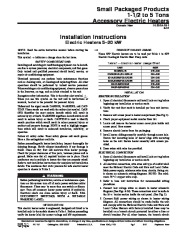| Categories | Carrier HVAC Manuals |
|---|---|
| Document Type | Heating, Ventilating and Air Conditioning Manual Free Download. HAVC Operator's Instruction Manual. |
| Tags | Carrier 58G |
| Download File |
|
| Language | English |
| Product Brand | Carrier. Support Phone Number: In North America, please call 1-800-CARRIER for immediate customer assistance from 8:00a -5:00p (EST) weekdays , Heating, Ventilating and Air Conditioning - HVAC |
| Document File Type | |
| Publisher | corp.carrier.com |
| Wikipedia's Page | Carrier Corporation |
| Copyright | Attribution Non-commercial |
Small Packaged Products 1-1/2 to 5 Tons Accessory Electric Heaters Cancels: New IIK 601A-18-1 8-01 Installation Instructions Electric Heaters 520 kW NOTE: Read the entire instruction manual before starting the installation. This symbol indicates a change since the last issue. SAFETY CONSIDERATIONS Installing and servicing air conditioning equipment can be hazardous due to system pressures, electrical components, and fuel gases.
Only trained and qualified personnel should install, service, or repair air conditioning equipment. Untrained personnel can perform basic maintenance functions such as cleaning coils, or cleaning and replacing filters. All other operations should be performed by trained service personnel. When working on air conditioning equipment, observe precautions in the literature, on tags, and on labels attached to the unit. Recognize safety information. This is the safety-alert symbol. When you see this symbol on the unit and in instructions or manuals, be alert to the potential for personal injury. Understand the signal words DANGER, WARNING, and CAUTION. These words are used with the safety-alert symbol. DANGER identifies the most serious hazards which will result in serious injury or death. WARNING signifies a hazard which could result in serious injury or death. CAUTION is used to identify unsafe practices which would result in minor personal injury or product and property damage. NOTE is used to highlight suggestions which will result in enhanced installation, reliability, or operation. Follow all safety codes. Wear safety glasses and work gloves. Have a fire extinguisher available. Before proceeding with heater installation, inspect thoroughly for shipping damage. Notify shipper immediately if any damage is found. Clean all dirt, dust and moisture from heater package. Check for proper clearances of live parts, between phases and to ground. Make sure that all required barriers are in place. Check conductors run in multiple to insure that they are properly wired. Refer to unit installation instructions for complete unit installation details. The maximum duct static pressure for safe electric heater operation is shown in Table 2. DESCRIPTION AND USAGE These SPP Electric heaters are to be used per Table 1 in SPP Electric Cooling & Electric Heat Pump units. Table 1–Electric Heater Usage Chart UNIT 50GS/50JS 50GX/50GL/50JX/50JZ 601A/602B/702A/702B 602A/602B/702A/702B PA1P-B/PH1P-B PA2P-B/PH2P-B SIZE 018060 024060 024060 024060 018060 024060 INSTALLATION HEATER INSTALLATION 1. Open all electrical disconnects and install lock-out tag before beginning any installation or service work. 2. Verify that unit duct work is installed per base unit instructions. 3. Remove unit access panel to heater compartment (See Fig. 1). 4. Check proper equipment model number from list. 5. Locate and remove the heater access cover plate inside unit access panel. Save screws 6. Remove electric heater from the packaging. 7. Install heater, sliding assembly carefully through access hole. Ensure that mounting holes of heater align with mounting holes on the unit. Secure heater assembly with screws provided. 8. Dress wires with wire ties provided. ELECTRICAL CONNECTION 1. Open all electrical disconnects and install lock-out tag before beginning any installation or service work. 2. All electrical connections, wire sizes and type of conduit shall meet the National Electric Code and State and Local Codes. Main power supply, minimum wire sizes, circuits, fusing, etc. is shown on schematic wiring diagrams. NOTE: Use minimum 75° C copper wire only.









